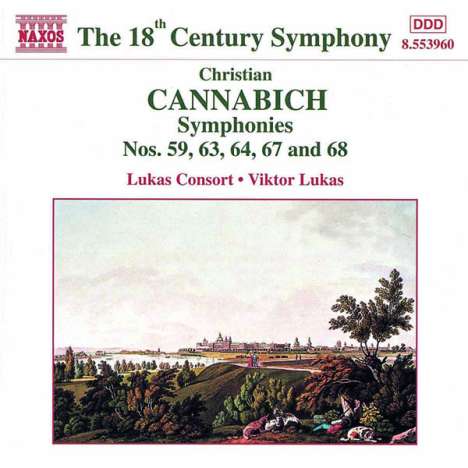Johann Christian Cannabich: Symphonien Nr.59,63,64,67,68 auf CD
Symphonien Nr.59,63,64,67,68
Herkömmliche CD, die mit allen CD-Playern und Computerlaufwerken, aber auch mit den meisten SACD- oder Multiplayern abspielbar ist.
- Künstler:
- Lukas Consort, Viktor Lukas
- Label:
- Naxos
- Aufnahmejahr ca.:
- 1996
- Artikelnummer:
- 8665469
- UPC/EAN:
- 0730099496025
- Erscheinungstermin:
- 7.9.1998
- Serie:
- Naxos 18th Century Classics
Sehr produktiv und erfolgreich als Komponist, und trotz der Vorbehalte Leopold Mozarts und in gewissem Maße auch seines Sohnes Wolfgang, hinterließ Cannabich mehr als siebzig Sinfonien, von denen der größte Teil in den vielen Jahren, die er in Mannheim verbrachte, entstanden zu sein schien. Die Sinfonie Nr. 59 in D-Dur ist für das konventionelle Orchester mit zwei Oboen, zwei Hörnern und Streichern geschrieben, und das einleitende Allegro beginnt mit einer starken Betonung der Tonika und der Dominante der Tonart, dem Anfangsmotiv, das die erste und zweite Violine gemeinsam haben. Die Oboen, die sich nicht mehr wie zu Beginn verdoppeln, bieten im Duett ein weiteres Element des ersten Themas. Es gibt kontrastierendes Material in einer Exposition, die nicht wiederholt wird, und eine kurze Durchführung vor der Reprise und der abschließenden Coda. Das G-Dur-Andante bietet Themen in Tonika und Dominante, die dann in der Reprise in der Tonika-Tonart wiederkehren. Das abschließende Presto folgt ohne Unterbrechung, wobei es seinem wiederkehrenden Hauptthema eine Nebenepisode in Triolen gegenüberstellt und, wie an anderer Stelle in der Sinfonie, für bekannte Merkmale des Mannheimer Stils sorgt, nämlich die Verwendung von großen Sprüngen in den Violinen und von dynamischen Veränderungen, die unter Cannabich ein Wunder der Orchesterdisziplin waren.
Product Information
Prolific and successful as a composer, in spite of the reservations felt by Leopold Mozart and to some extent by his son Wolfgang, Cannabich left more than seventy symphonies, the greater part seemingly written during the many years he spent in Mannheim. Symphony No. 59 in D major is scored for the conventional orchestra of two oboes, two horns and strings and the opening Allegro starts with a strong emphasis on the tonic and dominant of the key, the initial motif shared by the first and second violins. Oboes, no longer doubling as they had done at first, provide, in duet, a further element of the first subject. There is contrasting material in an exposition that is not repeated and a brief development before the recapitulation and final coda. The G major Andante offers subjects in tonic and dominant which then return in recapitulation in the tonic key. The final Presto follows without a break, contrasting its recurrent principal theme with a secondary episode in triplets and providing, as elsewhere in the symphony, for well known features of Mannheim style, the use of wide leaps in the violins and of dynamic changes, which, under Cannabich, were a wonder of orchestral discipline.
Rezensionen
»Rund neunzig Sinfonien hinterließ Christian Cannabich; und keine einzige findet sich im aktuellen ›Bielefelder‹. Ansätze zum Abbau dieses Defizits sind mit Erscheinen der vorliegenden Produktion gegeben, die sich durch kammermusikalische Transparenz, gut ausbalancierte Dynamik und klare Präsenz auszeichnet und uns ein bisher vernachlässigtes Kapitel kultureller ›heiler Welt‹ wieder erschließt.« (G. Wienke in FONO FORUM, Februar 1999)Disk 1 von 1 (CD)
-
1 Symphony No. 63 in D major: I. Grave: Allegro
-
2 Symphony No. 63 in D major: II. Andante moderato
-
3 Symphony No. 63 In D Major: Iii. Presto
-
4 Symphony No. 67 in G major: I. Allegro
-
5 Symphony No. 67 in G major: II. Andante con moto
-
6 Symphony No. 67 In G Major: Iii. Presto
-
7 Symphony No. 64 in F major: I. Allegro
-
8 Symphony No. 64 in F major: II. Andante
-
9 Symphony No. 64 In F Major: Iii. Allegro Molto
-
10 Symphony No. 59 in D major: I. Allegro
-
11 Symphony No. 59 in D major: II. Andante
-
12 Symphony No. 59 In D Major: Iii. Presto
-
13 Symphony No. 68 in B flat major: I. Allegro
-
14 Symphony No. 68 in B flat major: II. Andante moderato assai
-
15 Symphony No. 68 In B Flat Major: Iii. Allegro Vivace
Mehr von Johann Christia...






